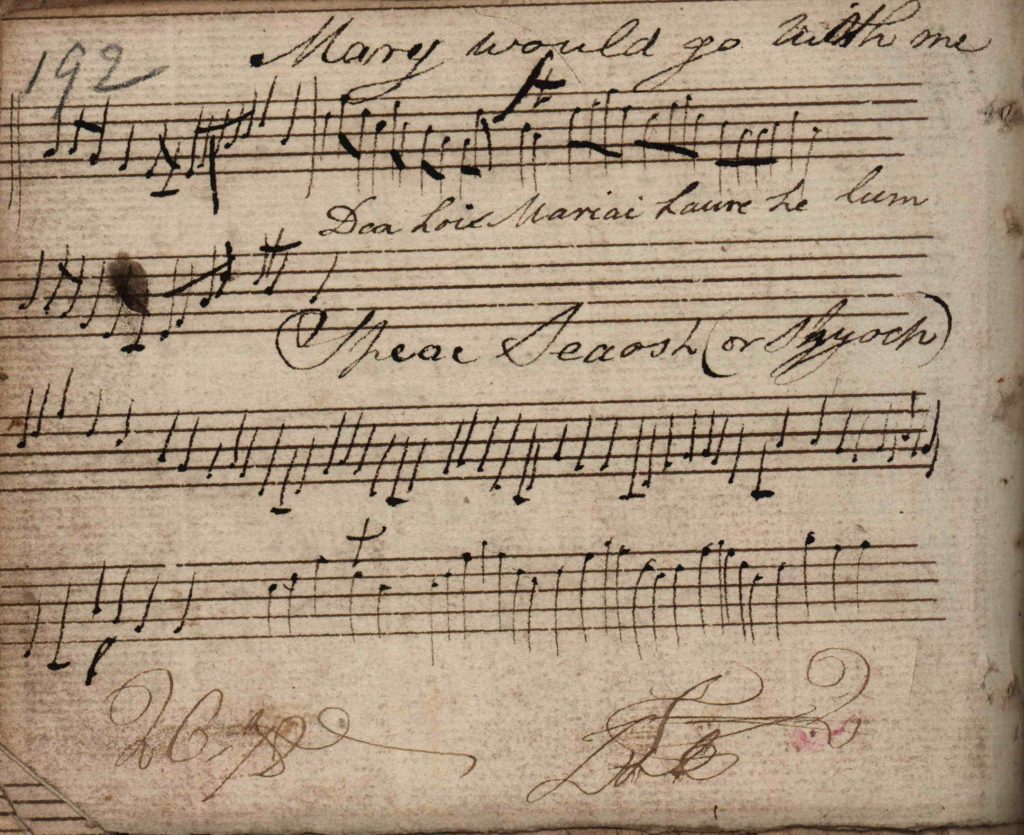I feel like I am not making much progress going through the “Damn your Body” pamphlet, because even after looking closely at each notation I don’t have much to say about whether it is a harp transcription or how it fits into the old harp tradition. I fear that this next tune, D’éalaigh Máire Liom, on page 192, is another unsatisfactory one. But I’ll do a summary post on it, because the only other option is to give up and skip over it, and I am not ready to do that yet. I would rather have an informed opinion about every page of the manuscript, even if that opinion ends up being “I have no idea what is going on with this notation”.
Donal O’Sullivan (Bunting part 2, 1930, p.20) says that Bunting printed two “sets” of the tune of D’éalaigh Máire Liom as no.41 in his 1797 publication.
For the first set, O’Sullivan says that “no copy of it appears to be in these manuscripts”, but we can recognise it on p.111, the first page of part two of MS4.29, which is a section which I think Bunting made when he was collecting songs with Kirwan in Connaught in summer 1792. The attribution tag in the annotated 1797 book says “Deel Castle” near Ballina, which is one of the places they were at, and so I think we can accept that attribution and source. I’ll not look at that version further, because I’m not going to work through the Mayo song airs for this project.
Donal O’Sullivan says that the “Second set” “seems to have been obtained in the same neighbourhood” but I don’t think there is any evidence for that. There is no attribution tag in the annotated 1797 printed book for this suggestion. And we can recognise the transcription notation on QUB SC MS4.29 p.192 as the source for the printed “second set”, and this is in part 3 of MS4.29 which seems to have tunes transcribed from harpers and other musicians mostly in Ulster, not singers in Connaught. And it is in the “Damn your Body” pamphlet, but we are struggling to understand that pamphlet at the moment…
Other versions of our tune
O’Sullivan usefully gives references to other printed versons, including two both from 1786, before Bunting was out collecting. One is in Thompson’s Hibernian Muse (no.xxix, p.17), and the other is in Walker’s Irish Bards (no.vii in the 1786 first edition). We know that Bunting had access to Walker’s book, and I find it suspicious that MS4.29 page 192 contains two tunes which also appear in Walker, our tune (Walker no.vii) and Spéic Seóigheach (Walker no.xii). But the versions on p.192 seem different enough that I don’t think they are just copied from Walker or from Thompson.
Title
The page 192 transcription page says “Mary would go with me / Dea lioc Mariai Laure he lum”. This kind of matches the 1798 printed title “Deoleoghadh maire lum / Mary do you fancy me”, which we can normalise as “D’éalaigh Máire liom”, Mary escaped with me. But what about the extra word or syllables “…ai Laure he …” in Bunting’s phonetics?
I’m noting the title doodled onto another page of the “Damn your Body” pamphlet: “mary would go with me” upside down on p.189. I am wondering if these cross-page references within the pamphlet are significant for indicating original groupings or common sources within a collecting session?
The transcription notation

I don’t even know how to understand this notation. It seems straightforward enough as A major, the same as in the 1797 printed piano arrangement, which would require three sharps. That is not a traditional harp key. I suppose it is possible that this is a harp transcription that has been written one note higher than it was played, which could imply it is a G major harp tune with F♯ tuned on the harp. But none of these other tunes in the “Damn your Body” pamphlet seem to be one up. So my suspicion at this stage is that it may have been transcribed at pitch from a singer.
I’m adding notes as I go to my Old Irish Harp Transcriptions Project Tune List Spreadsheet; that way if there are emergent patterns from collating so many pages and their contents we might start to get a sense of what is going on. You can also check my MS4.29 textual content PDF to see how the pages relate to each other.
Many thanks to Queen’s University Belfast Special Collections for the digitised pages from MS4 (the Bunting Collection), and for letting me use them here.
Many thanks to the Arts Council of Northern Ireland for helping to provide the equipment used for these posts, and also for supporting the writing of these blog posts.


One thought on “D’éalaigh Máire Liom”